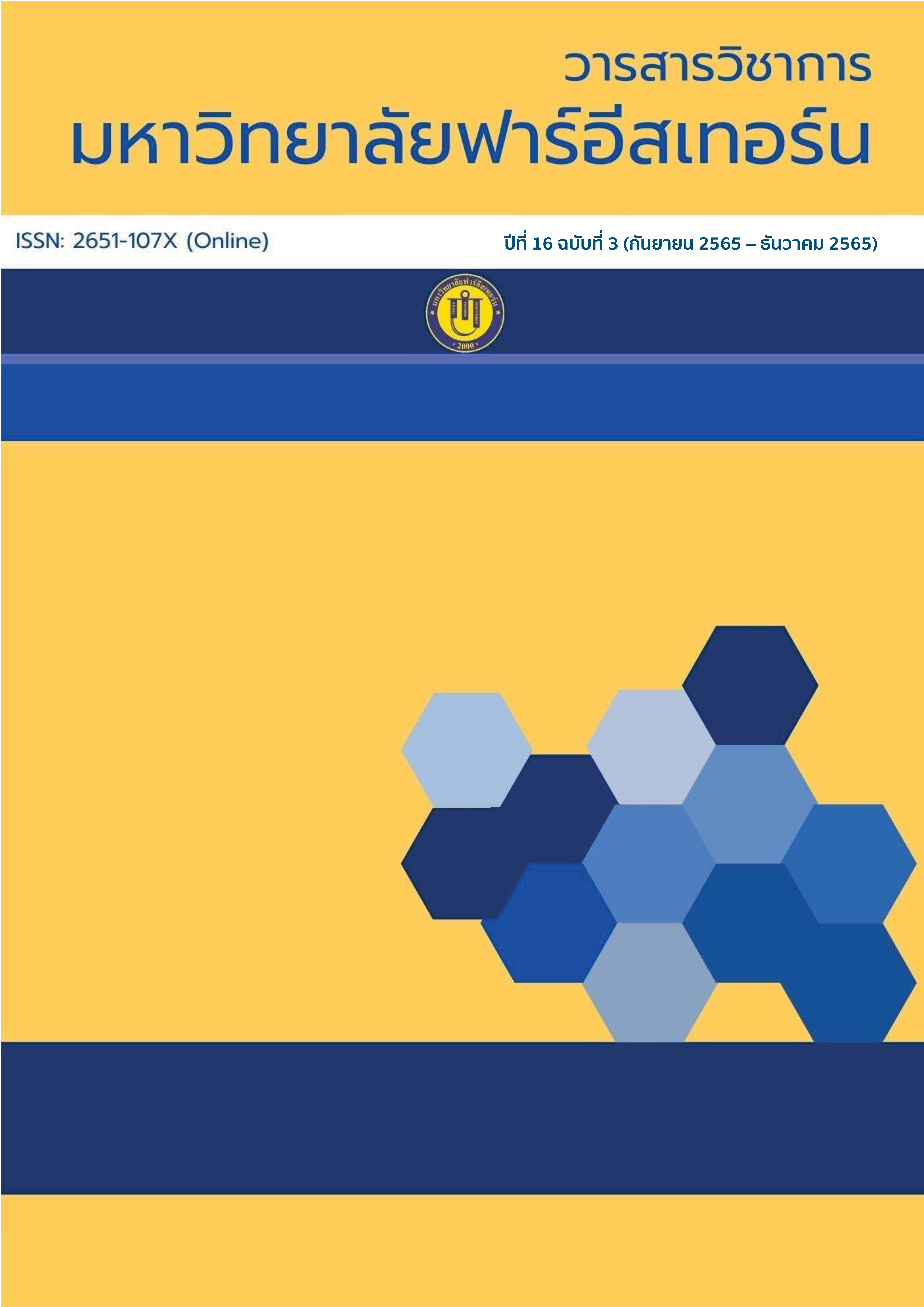The Effects of Using Mu-Mo Programs to Reduce Repetitive Behaviors among Children with Autism
Main Article Content
Abstract
The objectives of the study were: 1) to examine the effects of using Mu-Mo Programs to reduce repetitive behaviors among children with autism, 2) to compare repetitive behaviors among children with autism before and after using by Mu-Mo Programs. The target were 3 autistic students 7-10 years old, who have repetitive behaviors, healthy, unable to communicate but able to follow instructions, studying in early intervention of Singburi Special Education Center in the second semester of 2563 academic year, selected by purposive sampling. The instruments of this study were 1) the 5 lesson plans of Mu-Mo programs and 2) the repetitive behavioral observation. Data were analyzed using frequency value and percentage value. The findings were as follows; 1) the effects of using Mu-Mo Programs is repetitive behaviors among children with autism are reduced. The first children reduced 42.58%. The second children reduced 45.92% and the third children reduced 42.90% 2) After using Mu-Mo programs, the repetitive behaviors of all three children with autism were decreased when compared to before using Mu-Mo programs.
Article Details

This work is licensed under a Creative Commons Attribution-NonCommercial-NoDerivatives 4.0 International License.
1. Any views and comments in the Journal of Social Innovation and Lifelong Learning are the authors’ views. The editorial staff have not to agree with those views and it is not considered as the editorial’s responsibility.
2. The responsibility of content and draft check of each article belongs to each author. In case, there is any lawsuit about copyright infringement. It is considered as the authors’ sole responsibility.
3. The article copyright belonging to the authors and The Far Eastern University are copyrighted legally. Republication must be received direct permission from the authors and The Far Eastern University in written form.
References
กานดา โต๊ะถม. (2551). กิจกรรมการเคลื่อนไหวสำหรับเด็กพิเศษระดับปฐมวัย. กรุงเทพฯ: ภาคการศึกษาพิเศษ คณะครุศาสตร์ มหาวิทยาลัยราชภัฏสวนดุสิต.
กุลยา ก่อสุวรรณ. (2540). การลดพฤติกรรมซ้ำ ๆ แปลก ๆ ของเด็กที่ความบกพร่องทางสติปัญญาในโรงพยาบาลราชานุกูล โดยให้การเสริมแรงแบบดีอาร์โอร่วมกับการให้อยู่นิ่ง. [วิทยานิพนธ์ปริญญามหาบัณฑิต, มหาวิทยาลัยศรีนครินทรวิโรฒประสานมิตร].
จรินทร์ ธานีรัตน์. (2524). กีฬาเพื่อมวลชน. วารสารสุขศึกษา พลศึกษา และสันทนาการ, 7(202), 37-38.
ชลธิชา สุดาลักษณ์ และ มลิวัลย์ ธรรมแสง. (2556). การลดพฤติกรรมซ้ำ ๆ ของเด็กออทิสติกโดยการออกกำลังกายแบบมีโครงสร้างทางสายตา โดยวิธีการ TEACCH. วารสารวิชาการบัณฑิตวิทยาลัยสวนดุสิต, 9(3), 59-70. http://www.graduate.dusit.ac.th/journal/index.php/sdujournal/article/view/746
ชาตรี วิฑูรชาติ. (2546). “ออทิสซึม” ในกุมารเวชศาสตร์ เล่ม 1. เรือนแก้วการพิมพ์.
ดุษฎี บริพัตร ณ อยุธยา. (2522). หนังสืออุเทศวิธีการสอนดนตรีนาฏศิลป์เบื้องต้น. กรมวิชาการ กระทรวงศึกษาธิการ.
บุญเลิศ คำปัน. (2555). การให้ความช่วยเหลือเด็กกลุ่มเสี่ยงและกลุ่มมีปัญหา. สมาคมจิตวิทยาการปรึกษาและการแนะแนวภาคเหนือ. http://ncga.in.th/pariyattitham/boonlert.pdf
ประกาศกระทรวงศึกษาธิการ เรื่อง กำหนดประเภทและหลักเกณฑ์ของคนพิการทางการศึกษา พ.ศ. 2552. (2552, 8 มิถุนายน). ราชกิจจานุเบกษา. เล่ม 126 ตอนพิเศษ 80 ง. หน้า 45-47.
ผดุง อารยะวิญญู. (2541). การศึกษาสำหรับเด็กที่มีความต้องการจำเป็นพิเศษ. สำนักพิมพ์บรรณกิจ.
พลิศรา อังศุสิงห์. (2548). Music Therapy and Autism. มหาวิทยาลัยมหิดล คณะแพทยศาสตร์โรงพยาบาลรามาธิบดี. https://www.rama.mahidol.ac.th/ramamental/sites/default/files/public/pdf/Music%20therapy%20and%20autism.pdf
พัชรี ผลโยธิน. (2537). การจัดกิจกรรมและประสบการณ์ในระดับปฐมวัยศึกษา. เอกสารการสัมมนาการศึกษาปฐมวัย หน่วยที่ 4 – 7. กรุงเทพฯ : โรงพิมพ์สหมิตร.
แพง ชินพงศ์. (2557). ความพิเศษของดนตรี...พัฒนาเด็กพิเศษ. MGR Online. https://mgronline.com/qol/detail/9570000067415
พุฑฒิพงษ์ เพชรรัตน์. (2552). การศึกษาพฤติกรรมซ้ำๆ ของนักเรียนออทิสติกอายุ 7-10 ปีในโรงเรียนศึกษาพิเศษจากการใช้โปรแกรมปรับพฤติกรรมกิจกรรมการเคลื่อนไหว. [วิทยานิพนธ์ปริญญามหาบัณฑิตสาขาวิชาการศึกษาพิเศษ บัณฑิตวิทยาลัย, มหาวิทยาลัยศรีนครินทรวิโรฒ].
รุ่งนภา ทรัพย์สุพรรณ. (2546). การศึกษาผลของกิจกรรมกระตุ้นการรับความรู้สึกและการเคลื่อนไหวโดยครอบครัวที่มีต่อการแสดงพฤติกรรมซ้ำ ๆ แปลก ๆ การเล่นอย่างเหมาะสมและการมีปฏิสัมพันธ์กับผู้ใหญ่ของเด็กออทิสติก. [วิทยานิพนธ์ปริญญามหาบัณฑิต, มหาวิทยาลัยศรีนครินทรวิโรฒประสานมิตร].
สถาบันราชานุกูล. (2550). โปรแกรมนันทนาการสำหรับเด็กออทิสติก. โรงพิมพ์ สกสค.
สมโภชน์ เอี่ยมสุภาษิต. (2540). การปรับพฤติกรรม. สำนักพิมพ์จุฬาลงกรณ์มหาวิทยาลัย.
สุดธิดา ติณะมาศ. (2552). การลดภาวะไม่อยู่นิ่งในเด็กออทิสติกโดยใช้เทคนิคสโนซีเล็น [การค้นคว้าอิสระปริญญามหาบัณฑิต, มหาวิทยาลัยเชียงใหม่]. ศูนย์ข้อมูลวิจัย Digital “วช”. https://doi.nrct.go.th/ListDoi/listDetail?Resolve_DOI=10.14457/CMU.the.2009.258
ไหมไทย ไชยพันธุ์. (2557). จิตวิทยา: แนวคิดทฤษฎีการศึกษาการปรับพฤติกรรมในชั้นเรียน. วารสารมหาวิทยาลัยนราธิวาสราชนครินทร์ สาขามนุษยศาสตร์และสังคมศาสตร์, 1(1), 21-33. https://so05.tci-thaijo.org/index.php/pnuhuso/article/view/53485/44342
อนุสิทธิ์ ภิญโญฤทธิ์. (2555, 28 สิงหาคม). คุณค่าของดนตรี. Kruanusit. https://bit.ly/3mg3exA.
Balsara, J. J., Jadhav, J. H., Muley, M. P., & Chandorkar, A. G. (1979). Effect of drugs influencing central serotonergic mechanisms on methamphetamine-induced stereotyped behavior in the rat. Psychopharmacology, 64(3), 303–307.
Chan, S. (2007). Grasping Africa: A Tale of Achievement and Tragedy. London: IB Tauris.
Kenberger, F. (1979). Relation Training with Aggressive Mentally Retarded Adults. Ohio: Dissertation.

